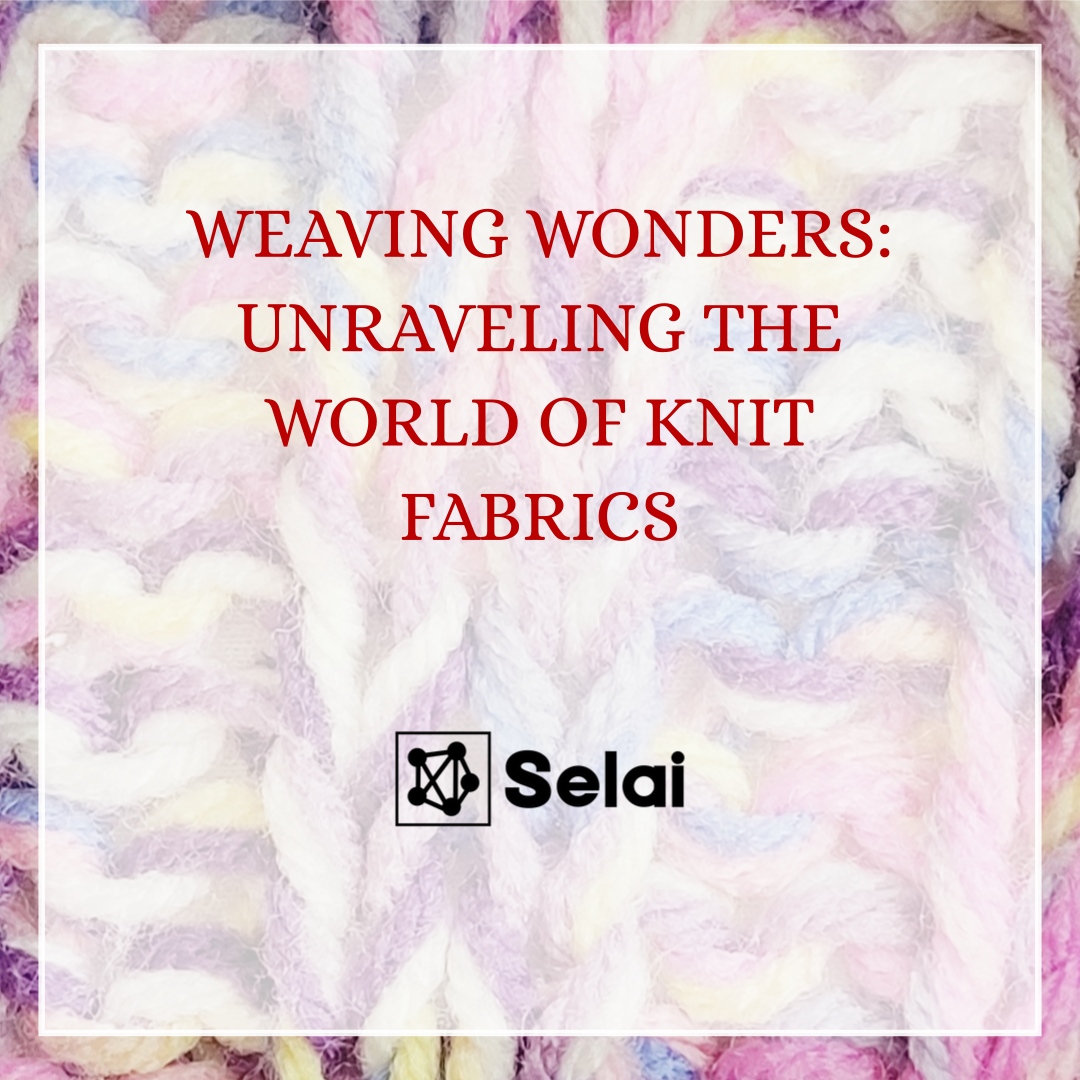
Knit fabrics are one of the pivotal elements of the textile industry, renowned for their flexibility, versatility, and unparalleled comfort. They are crafted through an intricate process of interlocking yarns, resulting in a diverse array of fabrics suited for varying purposes. This article explores the myriad facets of knit fabrics, illuminating their benefits, challenges, and their pivotal role in shaping the textile landscape.
Understanding Knit Fabrics:
Knit fabrics are constructed through a knitting process where loops of yarn are interlocked, creating a flexible and elastic fabric. They can be categorized mainly into two types: weft knit and warp knit. Weft knit fabrics, like jerseys, are made with a single yarn, making them stretchier and more suitable for casual wear. Warp knit fabrics, like tricot, involve multiple yarns and exhibit less stretch, often used in lingerie and swimwear.
Benefits of Knit Fabrics:
a) Comfort:
Knits are synonymous with comfort. Their inherent stretchability and softness make them ideal for a range of garments, including t-shirts, leggings, underwear, and more.
b) Versatility:
Knits are highly adaptable, coming in various weights, textures, and fibers. This versatility enables their use in both summer tees and cozy winter sweaters.
c) Durability:
When constructed well, knit fabrics can withstand wear and tear, maintaining their shape and texture even after numerous washes.
d) Breathability:
Knits are often more breathable compared to woven fabrics, making them perfect for sportswear and summer attire.
e) Elasticity:
The inherent elasticity in knits offers a comfortable fit, accommodating diverse body types and movements.
f) Wrinkle Resistance:
Many knit fabrics are less prone to wrinkling, reducing the need for ironing and ensuring a polished appearance.
Challenges with Knit Fabrics:
a) Shrinkage:
Knits tend to shrink more than woven fabrics, necessitating pre-wash treatments or careful laundering to maintain size and shape.
b) Pilling:
Some knits, especially those made with synthetic fibers, are prone to pilling over time, impacting the fabric’s aesthetic and texture.
c) Snagging:
The looped structure of knits makes them susceptible to snagging, which can lead to runs or holes in the fabric.
d) Complexity in Manufacturing:
Producing high-quality knits requires precision and expertise, especially in maintaining consistent tension to avoid irregularities and deformities in the fabric.
Applications of Knit Fabrics:
Knit fabrics transcend the realms of fashion, extending to home décor, medical supplies, and industrial applications. Their diverse utility includes:
Sustainable Practices in Knit Fabric Production:
Sustainability is increasingly pivotal in knit fabric production. Brands and manufacturers are adopting eco-friendly fibers, ethical manufacturing practices, and waste-reducing technologies to minimize environmental impact. Organic cotton, bamboo, and recycled fibers are gaining traction as sustainable alternatives in knit production.
Selecting the Right Knit Fabric:
When choosing knit fabrics, consider the fabric’s stretch, weight, drape, and recovery. The end-use, desired fit, and comfort level will guide the selection process, ensuring the chosen knit aligns with the garment’s purpose and wearer’s preference.
Here is a list of common knit products:
* T-shirts: The most common garment made from knit fabric, available in various styles and designs.
* Polo shirts: Collared T-shirts typically made from piqué knit fabric.
* Tank tops / Singlets: Sleeveless shirts commonly used for casual wear or as undershirts.
* Sweaters: While many sweaters are hand-knit, commercial sweaters are often machine-knit from yarns like wool, cotton, or synthetic fibers.
* Dresses: Knit dresses are popular for their comfort and drape. They can range from casual to formal.
* Leggings: Stretchable, close-fitting pants that are popular for comfort.
* Yoga pants and athletic wear: Knit fabrics are often used for sportswear because of their flexibility.
* Sweatshirts and Hoodies: Typically made from a fleece knit, offering warmth and comfort.
* Sweatpants / Joggers: Casual pants made from soft knit fabrics, often paired with sweatshirts or hoodies.
* Underwear: Includes briefs, boxers, and boxer briefs for men and panties for women.
* Bras: Many bras, especially sports bras, are made from knit materials due to their stretch and comfort.
* Socks: Knit fabrics provide the stretchability required for snug-fitting socks.
* Baby clothes: Rompers, onesies, and other baby clothes are often made from soft knits for comfort.
* Nightwear: Includes pajamas, nightgowns, and other sleepwear items.
* Beanies / Knit caps: Headwear made from knit fabrics to provide warmth.
* Scarves: Many scarves, especially those for colder weather, are made from knit materials.
* Turtlenecks: High-neck shirts ideal for colder weather.
* Henley shirts: Similar to T-shirts but with a buttoning placket at the neck.
* Cardigans: Open-front or buttoned sweaters.
* Rompers and jumpsuits: One-piece garments made from knit fabrics for both adults and kids.
* Swimwear: Some swimwear items, especially rash guards, are made from knit fabrics.
* Skirts: Stretchable knit skirts in various lengths and styles.
* Bodysuits: Fitted one-piece garments that stretch from the shoulders to the crotch, often used for layering.
* Tube tops: Strapless, sleeveless tops made from stretchy knit fabrics.
* Camisoles: Thin-strapped tops, often used as undershirts or worn alone for a light and airy look.
* Crop tops: Shorter shirts that end above the waist or just at the waistline.
* Thermal wear: Knitted garments designed to retain body heat, often used as a base layer in cold climates.
* Racerback tops: Tops with shoulder straps that converge between the shoulder blades, popular for sportswear.
* Bandeau: A strapless piece of fabric wrapped around the bust.
* Shrug: A cropped, cardigan-like garment with short or long sleeves, covering the shoulders and the upper part of the torso.
* Tunic: A longer top, often reaching the thighs, which can be worn with leggings or tights.
* Knee-high socks and stockings: Stretchy knit socks that reach up to the knee or thigh.
* Arm warmers: Knitted sleeves are designed to warm the arms, often fingerless.
* Leg warmers: Knitted tubes worn over the calf, popularized in the 1980s aerobic workouts.
* Mittens and gloves: Hand coverings made from knit fabrics.
* Neck warmers / Snoods: Circular knit scarves that sit around the neck.
* Ear warmers / Headbands: Knit bands that go over the head to cover the ears in cold weather.
* Jerseys: Sport-specific shirts, especially for activities like cycling.
* Gaiters: Used to cover the neck, face, or even legs in certain outdoor activities.
* Balaclavas: Full-head coverings, leaving only parts of the face exposed, often used in extremely cold conditions.
* Boot cuffs: Knit bands worn at the top of boots for style or added warmth.
* Infinity scarves: Circular scarves without ends that can be looped around the neck multiple times.
* Peplum tops: Tops with a flared ruffle at the waist.
* Muscle tees: Sleeveless shirts with open armholes.
* Mesh tops: Loosely knit tops, often layered over other garments.
* Slip dresses: Dresses made of finer knits, often with spaghetti straps.
* Knit vests: Sleeveless garments that can be worn over shirts or blouses.
* Bikini tops and bottoms: Some swimwear is made from special knit fabrics designed to be water-resistant and quick-drying.
Knit fabrics intertwine comfort, versatility, and innovation, enriching our wardrobes and lives with their unique charm. While they bring unparalleled benefits, understanding their challenges is crucial for optimal utilization. As the textile industry evolves, knit fabrics continue to adapt, reflecting advancements in technology, sustainability, and design. By appreciating the complexities and possibilities knit fabrics offer, we weave a richer, more harmonious tapestry of life.
This exploration into the world of knit fabrics underscores their significance and versatility, highlighting the need for informed choices, ethical practices, and a continual appreciation for the woven wonders that clothe us, comfort us, and connect us to the intricate, beautiful world of textiles.
